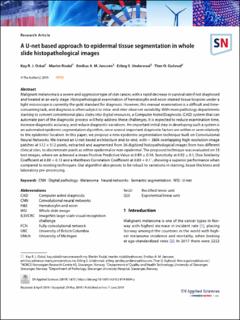| dc.contributor.author | Oskal, Kay Raymond | |
| dc.contributor.author | Risdal, Martin | |
| dc.contributor.author | Janssen, Emiel | |
| dc.contributor.author | Undersrud, Erling Sandøy | |
| dc.contributor.author | Gulsrud, Thor Ole | |
| dc.date.accessioned | 2020-05-20T09:36:03Z | |
| dc.date.available | 2020-05-20T09:36:03Z | |
| dc.date.created | 2019-06-12T13:52:28Z | |
| dc.date.issued | 2019-06 | |
| dc.identifier.citation | Oskal, K.R.J., Risdal, M., Janssen, E.A.M. et al. (2019) A U‑net based approach to epidermal tissue segmentation in whole slide histopathological images. SN Applied Sciences. | en_US |
| dc.identifier.issn | 2523-3963 | |
| dc.identifier.uri | https://hdl.handle.net/11250/2655115 | |
| dc.description.abstract | Malignant melanoma is a severe and aggressive type of skin cancer, with a rapid decrease in survival rate if not diagnosed and treated at an early stage. Histopathological examination of hematoxylin and eosin stained tissue biopsies under a light microscope is currently the gold standard for diagnosis. However, this manual examination is a difficult and time-consuming task, and diagnosis is often subject to intra- and inter-observer variability. With more pathology departments starting to convert conventional glass slides into digital resources, a Computer Aided Diagnostic (CAD) system that can automate part of the diagnostic process will help address these challenges. It is expected to reduce examination time, increase diagnostic accuracy, and reduce diagnostic variations. An important initial step in developing such a system is an automated epidermis segmentation algorithm, since several important diagnostic factors are within or seen relatively to the epidermis’ location. In this paper, we propose a new epidermis segmentation technique built on Convolutional Neural Networks. We trained an U-net based architecture end-to-end, with ∼380k overlapping high resolution image patches at 512 × 512 pixels, extracted and augmented from 36 digitized histopathological images from two different clinical sites, to discriminate pixels as either epidermal or non-epidermal. The proposed technique was evaluated on 33 test images, where we achieved a mean Positive Predictive Value at 0.89±0.16, Sensitivity at 0.92±0.1, Dice Similarity Coefficient at 0.89±0.13 and a Matthews Correlation Coefficient at 0.89±0.11, showing a superior performance when compared to existing techniques. Our algorithm also proves to be robust to variations in staining, tissue thickness and laboratory pre-processing. | en_US |
| dc.language.iso | eng | en_US |
| dc.publisher | Springer International Publishing | en_US |
| dc.rights | Navngivelse 4.0 Internasjonal | * |
| dc.rights.uri | http://creativecommons.org/licenses/by/4.0/deed.no | * |
| dc.subject | melanoma | en_US |
| dc.subject | hudkreft | en_US |
| dc.subject | digital patologi | en_US |
| dc.subject | nevrale nettverk | en_US |
| dc.subject | semantisk segmentering | en_US |
| dc.subject | informasjonsteknologi | en_US |
| dc.title | A U‑net based approach to epidermal tissue segmentation in whole slide histopathological images | en_US |
| dc.type | Peer reviewed | en_US |
| dc.type | Journal article | en_US |
| dc.description.version | publishedVersion | en_US |
| dc.rights.holder | © The Author(s) 2019 | en_US |
| dc.subject.nsi | VDP::Medisinske Fag: 700::Klinisk medisinske fag: 750::Onkologi: 762 | en_US |
| dc.source.pagenumber | 12 | en_US |
| dc.source.volume | 1 | en_US |
| dc.source.journal | SN Applied Sciences | en_US |
| dc.identifier.doi | 10.1007/s42452-019-0694-y | |
| dc.identifier.cristin | 1704367 | |
| cristin.ispublished | true | |
| cristin.fulltext | original | |
| cristin.qualitycode | 1 | |

